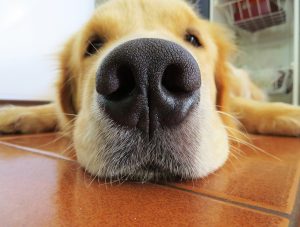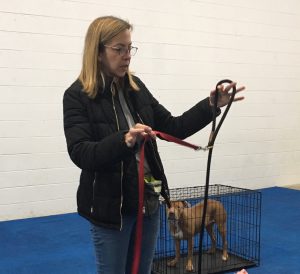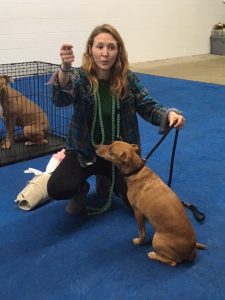Keep the Holidays Pet-Safe: Toxic Foods
 We’ve all heard stories about the determined pooch that pulled down and devoured most of the warm apple pie that had been on the kitchen counter, waiting to be taken to the Holiday dessert table. Or, the industrious kitty that dragged the turkey carcass off the Thanksgiving dinner table—while no one was watching—pulling it across the dining room floor to munch contentedly on some of its bones and fatty remains.
We’ve all heard stories about the determined pooch that pulled down and devoured most of the warm apple pie that had been on the kitchen counter, waiting to be taken to the Holiday dessert table. Or, the industrious kitty that dragged the turkey carcass off the Thanksgiving dinner table—while no one was watching—pulling it across the dining room floor to munch contentedly on some of its bones and fatty remains.
As wonderful as the Holidays can be—full of family, friends, food and fun—it’s our furry family members that need special attention. Amidst all the hustle and bustle, it’s easy to put out foods for your guests to enjoy—which can also be in dog-snatching or cat-licking reach. Many of these Holiday delicacies can actually be toxic to your pets.
It’s more than chocolate
Most pet owners know that chocolate is a no-no for dogs and can create digestive problems. So those plates of sweets are generally placed out of a dog’s reach and guests are asked to kindly refrain from sharing these goodies with the dog. However, there are many other holiday foods that can be equally dangerous, including:
Alcohol: Highly toxic, if ingested, pet may become weak, ill or even go into a coma.
Avocado: Primarily a problem for birds, can cause cardiovascular damage and even death.
Chocolate, Coffee, Caffeine: Contains substances called methylxanthines, which are found in cacao seeds. When ingested, can cause vomiting, diarrhea, panting, excessive thirst and urination, hyperactivity, abnormal heart rhythm, tremors, seizures and even death. Darker chocolate is more dangerous than milk chocolate. White chocolate has the lowest level of methylxanthines and baking chocolate has the highest level.
Citrus: The peel, fruit and seeds contain citric acid, which could cause irritation if eaten in large amounts. Small doses are not likely to cause problems beyond minor stomach upset.
Eggnog: Many eggnog recipes use nutmeg, which is toxic to dogs (see below).
Grapes and Raisins: Can cause kidney failure.
Macadamia Nuts: Can cause weakness, depression, vomiting, tremors and hyperthermia in dogs.
Milk and Dairy Products: Pets do not possess significant amounts of the enzyme that breaks down lactose, so these products can cause diarrhea or other digestive upset.
Nutmeg: Ingesting large amounts of this spice can cause upset stomach, disorientation, increased heart rate, high blood pressure, dry mouth, abdominal pain and seizures. It’s best to keep this spice jar stowed away and capped tightly.
Nuts: Because they contain high amount of oils and fats, ingesting a large amount could cause vomiting and diarrhea.
Onions, Garlic, Chives: Cats are more susceptible to gastrointestinal irritation if ingested. Dogs can be affected if large amount are eaten.
Raw/Undercooked Meat, Eggs, Bones: May contain Salmonella and E. coli, which can be harmful to pets as well as humans. Bones from cooked fowl, like turkey or chicken, can be highly dangerous. They my splinter and become lodged in or puncture the pet’s digestive tract.
Salt and Salty Snacks: Ingested in large amounts can develop electrolyte abnormalities, which may cause vomiting, diarrhea, depression, tremors, elevated body temperature, seizures and even death.
Xylitol: A common sweetener, which can cause insulin release in most species. The increase in insulin can lead to hypoglycemia (lowered sugar levels), which can cause vomiting, lethargy, loss of coordination, and possible seizures. Symptoms can be seen within a few days of ingestion.
In addition to Holiday foods, seasonal plants and decorations can be a source of danger to your pets.
- Water under the Christmas tree may contain toxic preservatives, or can become stagnant and grow bacteria that could cause nausea or diarrhea if your pet drinks it.
- Mistletoe and Holly, if ingested, can irritate the digestive system causing nausea, vomiting and diarrhea.
- Lillies can cause kidney failure in cats if ingested.
- Tinsel and ribbons can be a fun cat or dog toy, but, if swallowed, can cause serious intestinal problems
To be safe, try decorating with artificial plants, or plants that are pet-safe.
Have a people and pet-safe Holiday!
To avoid a run to the vet after a holiday gathering, keep your pets on their normal diet. If you want to give them a treat, make sure it’s a treat made especially for them. Just in case, here are two Pet Poison Hotlines recommended by the Cornell University College of Veterinary Medicine. They are available 24 hours a day, and may charge a nominal fee for their services:
Pet Poison Hotline
800-213-6680
http://www.petpoisonhelpline.com/
ASPCA Animal Poison Control Center
888-426-4435
https://www.aspca.org/pet-care/animal-poison-control
For more information, visit these sites:
https://www.americanhumane.org/blog/no-tricks-just-treats-how-to-keep-your-pet-safe-this-halloween/
https://www.aspca.org/pet-care/general-pet-care/holiday-safety-tips
https://www.aspca.org/pet-care/animal-poison-control/people-foods-avoid-feeding-your-pets
https://www.humanesociety.org/resources/foods-can-be-poisonous-pets
https://www.peta.org/living/animal-companions/holiday-foods-that-are-bad-for-dogs/
https://www.thedodo.com/the-dodo-archive/holiday-safety-tips-for-pets
Never Underestimate the Power of the Canine Nose
 Those of us who love and have dogs, often pay a great deal of attention to their physical well being. Sometimes, however, we forget that dogs are driven by their noses. We walk them, run with them, and play fetch or Frisbee with them. Our dogs are happy we offer all this exercise, but sometimes they just want to sniff their world.
Those of us who love and have dogs, often pay a great deal of attention to their physical well being. Sometimes, however, we forget that dogs are driven by their noses. We walk them, run with them, and play fetch or Frisbee with them. Our dogs are happy we offer all this exercise, but sometimes they just want to sniff their world.
Humans are mostly sight driven, so we can forget to acknowledge the incredible investigative powerhouse sitting at the tip of every dog’s snout. There are up to 300 million olfactory receptors in a dog’s nose, compared to about 6 million is a human nose. Additionally, dogs have a proportionately larger part of their brain dedicated to analyzing smells. According to Alexandra Horowitz in her book Inside of a Dog, we might be able to smell whether or not our cup of coffee has sugar in it. A dog, on the other hand, could smell a teaspoon of sugar in a million gallons of water—which is equal to two Olympic-sized swimming pools!
Canines also have a special organ called Jacobson’s organ, which is at the bottom of their nasal passage. This organ detects pheromones and other chemical compounds. Thanks in part to this organ, dogs can sniff out things like drugs, cancer, bombs, bed-bugs, cadavers, wildlife scat, and even contraband electronics.
Why is this important?
We’ve all seen it—an owner is pulling at their dog that has stopped to sniff something on the ground, or around the neighborhood fire-hydrant. The owner wants to walk but the dog wants to sniff and learn everything it can about its environment. When the owner pulls a dog away from a scent, it’s like having someone take away the murder mystery you are reading just before you get to the part that tells you who-done-it!
A dog sniffs to learn about other dogs in the neighborhood, including their age, sex and health. It also sniffs to learn what other wildlife scampered through the back yard the previous night and where the best places are to eliminate in order to leave the dog’s own unique olfactory message. The act of sniffing on a walk is an exercise in communication. The scents the dog picks up, not only from other dogs, but also from the environment, are providing mental exercise, which is as important as the physical stimulation provided by the walk.
So, a successful dog walk will be a balance of healthy walking with a good dose of unimpeded sniffing. Your dog will be tired physically and mentally, which will make for a relaxed, happy and grateful canine companion.




